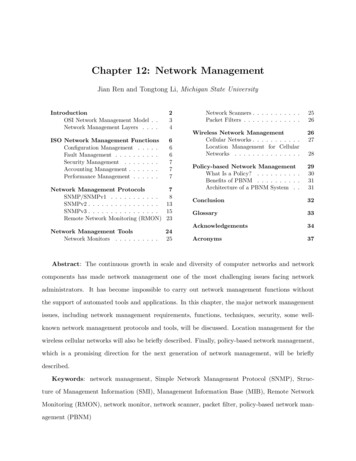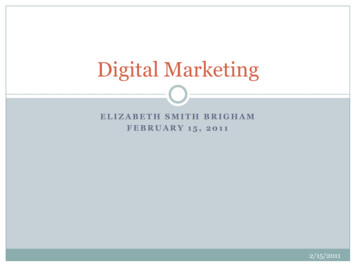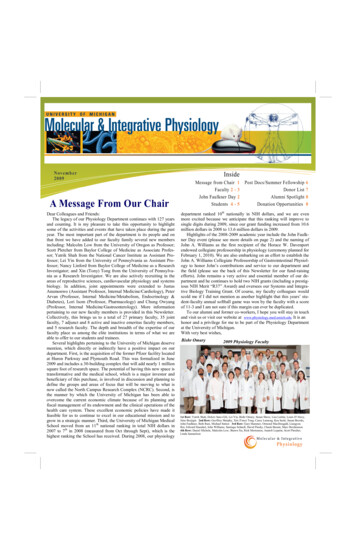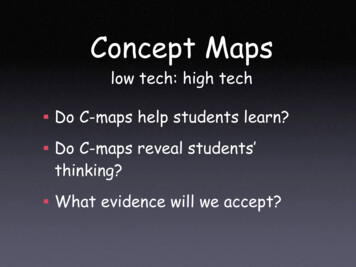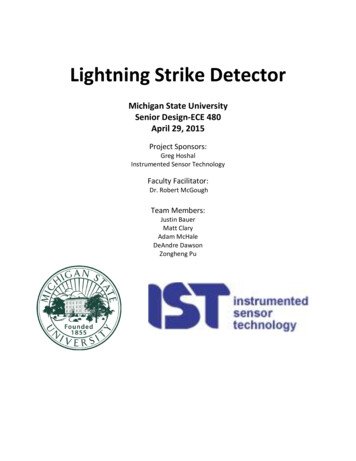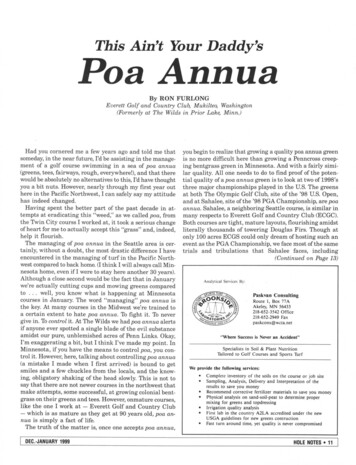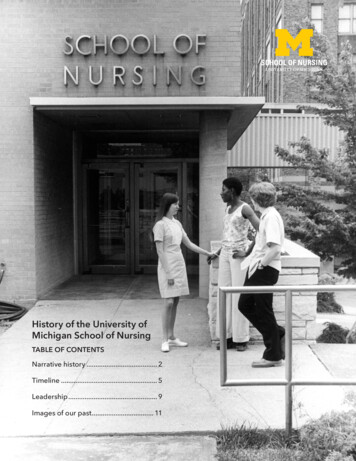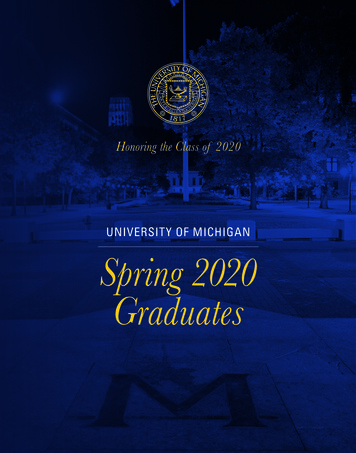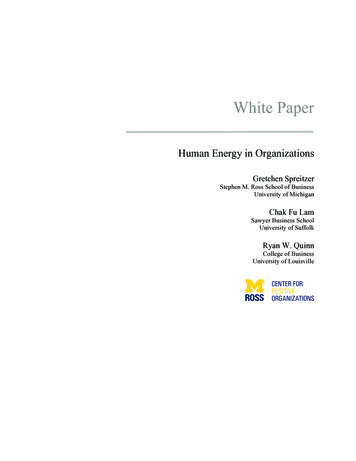
Transcription
White PaperHuman Energy in OrganizationsGretchen SpreitzerStephen M. Ross School of BusinessUniversity of MichiganChak Fu LamSawyer Business SchoolUniversity of SuffolkRyan W. QuinnCollege of BusinessUniversity of Louisville
Key Points: Energy can be generated or sustained, not just depleted or drained, in the doing of one’s work.Feeling energetic is the result of being engaged in one’s work.Leaders can take practical steps to cultivate and regulate energy at work.IntroductionToday, more than ever, people juggle multiple roles, work long hours, and are tethered to work throughtechnology. Fatigue is a culprit in occupational safety hazards, errors and poor performance, often leavingworkers with little energy for family or community activities. Clearly energy matters – yet what exactly isenergy? Identifying different types and causes of energy, and the lack of it, can help leaders understandwhat organizational conditions are likely to lead to the efficient (and incidentally, enjoyable and creative)use of human energy in the work that people perform.Six Streams of Energy-Related Organizations:There are disparate views of how work impacts energy and of why energy matters.To help leaders make sense of this, the literature is organized into six distinct streams:Stream 1: Ego-Depletion TheoryEgo-depletion theorists define energy as a physiological, finite and limited construct: Energy is depleted for activities that require a high level of self-control and choice decisions (e.g.coping with stress, emotion regulation, impulse resistance, maintaining physical stamina).Energy can be restored through rest or the ingestion of glucose.Unless energy is restored, employees may fail to self-control their subsequent behavior.Using energy to engage in self-control activities, though draining in the short run, can increaseone’s energy level for (related and unrelated) self-control activities over the long run.Stream 2: Attention Restoration Theory (ART)ART defines energy as an individual’s capacity to focus attention on cognitive tasks: Energy is drained through inhibiting distractions (e.g. worry, stress, and unrelated thoughts),information processing, and problem-solving activities.Energy can be restored in numerous ways other than glucose consumption.Employees are re-energized when they 1) Find fascination 2) Are in a different place physicallyand mentally from a demanding environment 3) Locate in a holistically rich ambience 4) Engagein activities that align with their personal preferences.Stream 3: Self-Determination Theory (SDT)SDT defines energy as subjective vitality, or a feeling of enthusiasm, feeling alive, and positive energy: Employees feel more vitality in self-directed activity than in controlled activity.Activities that satisfy people’s need for autonomy, competence and relatedness enhance energy.Stephen M. Ross School of Business, University of Michigan2
Some activities are more emotionally depleting than others, depending on the interest employeeshave in, or the feelings they have for, their activities.Stream 4: Energetic ArousalEA researchers define energy as feelings of enthusiasm, excitement, and vitality: Employees can engage in mood regulating behaviors (e.g. stress management, social interaction,physical exercise) to increase the feeling of energetic arousal.Energetic arousal facilitates creative outcomes, entrepreneurial passion, and mood convergence.Tense activation narrows employees’ attention, motivating them to address interruptions to theirexpectations and preparing them to act, which is a highly inefficient use of energy.Stream 5: Interactional Ritual Chain (IRC) TheoryIRC theorists define energy as the outcome of successful interaction rituals: Successful interaction rituals occur when employees 1) are co-present, 2) have boundariesdefining their participation in the interaction, 3) share the same focus of their attention, and 4)experience the same feelings about whatever they are focusing on.When employees experience successful interaction rituals, their individual energy increases, andthey identify with the people they interact with.As employees try to maximize their energetic arousal, they seek interactions that increaseenergetic arousal and avoid interactions that decrease it.Stream 6: Conservation of Resources (CoR)CoR researchers examine energy in terms of vigor, defined as an individual possessing physical presence,cognitive alertness, and emotional energy: Job resources and job demands are a strong predictor of vigor.Vigor is depleted when job demands are high, and the depletion of vigor over the long run islikely to lead to stress and emotional exhaustion.To restore vigor, employees must engage in recovery processes (e.g. detachment from work,relaxation, experiences of control during leisure time) or obtain job resources.Stephen M. Ross School of Business, University of Michigan3
Practical Implications:Looking across the six streams of energy research, there are three key facets of human energy:1) subjective 2) physiological, and 3) kinetic. These three types of energy interact with each other andhelp leaders understand what practical steps can be taken to foster energy in the workplace: While breaks and time away from work can be restorative for human energy, the content of workitself and the way that it is accomplished can also be restorative.Positive meaning, positive agency, positive emotions, and knowledge create feelings of vitality.Energy management strategies that are learning-oriented (e.g., set a new goal), relational (dosomething to make a colleague happy), and meaning-creating (reflect on the meaning of yourwork) are more related to having more energy than commonly reported energy managementstrategies such as switching tasks or taking a break.Positive energy is contagious across individuals and organizationsEnergy is a critical ingredient for fortifying individuals to see opportunities, and not just theinherent threat in crises and difficult times. Managers should think about ways to energize peopleto broaden their perspectives so that they can see possibilities for something new.Conclusion:In order to cultivate and regulate energy in the workplace, leaders must first understand the types andcauses of human energy. Energy at work is important because it is the basic fuel for individual action andcognition and because it plays a large role in determining employee behavior. Executives can takepractical steps to help employees cultivate and self-regulate their energy at and away from work.Take Action:ü Encourage your employees to take breaks that do not require high levels of self-control or choicedecisions.ü Limit distractions (e.g. worry, stress) and provide opportunities to psychologically detach fromwork.ü Help employees find work that is meaningful to them and consistent with their personalpreferences.ü Satisfy your employees’ need for relatedness, competence and autonomy at work.ü Provide opportunities for physical exercise, stress management (e.g. relaxation techniques) andsocial interactions to increase your employees’ energetic activation.ü Ensure that interaction rituals (e.g. meetings) leave you and your colleagues feeling energized.ü Monitor your employees’ workloads and ensure they have sufficient job resources (e.g.supervisory and coworker support, performance reviews) to complete their work.*This paper was summarized by Penelope Mallinckrodt (Ross MBA ‘13) based on chapter 12 of Cameron andSpreitzer’s (Eds.) The Oxford Handbook of Positive Organizational Scholarship (2012).Stephen M. Ross School of Business, University of Michigan4
About the Authors:Gretchen M. Spreitzer is the Keith E. and Valerie J. Alessi Professor of Business Administration andProfessor of Management and Organizations at the Ross School of Business. Her research focuses onemployee empowerment, leadership development, positive deviance, and how organizations enableemployees to flourish. Spreitzer also is a core faculty member of the Center for Positive Organizations atRoss.Chak Fu Lam, PhD ’13, is Assistant Professor of Management and Entrepreneurship at the University ofSuffolk’s Sawyer Business School.Ryan W. Quinn, PhD ’03, is Assistant Professor of Management in the University of Louisville’sCollege of Business.Stephen M. Ross School of Business, University of Michigan5
Stephen M. Ross School of Business, University of Michigan 2 Key Points: Energy can be generated or sustained, not just depleted or drained, in the doing of one’s work. Feeling energetic is the result of being engaged in one’s work. Leaders can take practical steps
